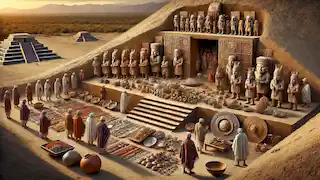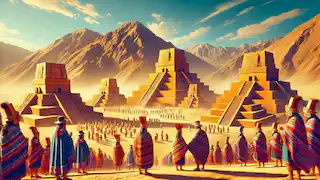The story of the Moche Lords of Sipán is one of the most fascinating tales in ancient South American history. The Moche civilization, which flourished on the northern coast of present-day Peru between AD 100 and 700, was known for its intricate artistry, engineering feats, and complex social structure. However, it was the discovery of the tombs of the Moche Lords in Sipán that provided the world with a glimpse into the wealth, power, and religious practices of this mysterious culture. The tombs revealed not only a sophisticated society but also offered insights into their beliefs surrounding life, death, and the afterlife.
The Rise of the Moche Civilization
The Moche civilization emerged along the northern coast of Peru, an arid desert region flanked by the Andes Mountains. Despite the harsh conditions, the Moche developed advanced irrigation systems that allowed them to cultivate crops and sustain their growing population. Their agricultural success laid the foundation for a complex society with distinct social classes, including rulers, warriors, artisans, and farmers.
As the Moche civilization expanded, so did its influence. They were skilled in metallurgy, pottery, and textile production. The Moche were also known for their impressive architecture, including massive adobe pyramids like the Huaca del Sol and Huaca de la Luna, which were ceremonial and administrative centers. The civilization's art, particularly its pottery, depicted scenes of everyday life, mythology, and ritual ceremonies, offering a window into their culture.
The Moche were ruled by a class of elite leaders, often referred to as the Lords of Sipán. These rulers held both political and religious power, serving as intermediaries between the people and the gods. The discovery of their tombs would later reveal the immense wealth and authority they commanded.

The Discovery of the Sipán Tombs
In 1987, Peruvian archaeologist Walter Alva and his team made a groundbreaking discovery in the Lambayeque Valley, near the town of Sipán. What they found would forever change our understanding of the Moche civilization. The discovery was a royal tomb, containing the remains of a high-ranking Moche lord, now known as the Lord of Sipán.
The tomb was a marvel of ancient engineering, consisting of several chambers filled with precious artifacts, including gold, silver, copper, and turquoise jewelry, as well as finely crafted pottery. The Lord of Sipán was buried with an entourage of attendants, including warriors, servants, and even animals, all of whom were sacrificed to accompany him into the afterlife.
This discovery was followed by the excavation of additional tombs, each revealing more about the Moche's elaborate burial rituals. The tombs contained layers of offerings and sacrifices, reflecting the Moche belief in the afterlife and the need to provide their rulers with everything they might need in the next world.
The treasures found in the Sipán tombs rival those of ancient Egypt's pharaohs, earning the site the nickname "The Tutankhamun of the Americas." The tombs not only provided evidence of the Moche's wealth but also shed light on their religious practices, including the worship of gods associated with fertility, war, and the sun.
The Lord of Sipán – A Glimpse into Moche Power
The Lord of Sipán, the most famous of the tomb's occupants, was likely a powerful ruler who lived around AD 300. His burial site revealed much about the hierarchy of Moche society and the role of religion in their governance. The Lord was adorned with intricate jewelry, including a large nose ring, ear spools, and a headdress, all made of gold and other precious metals. His attire signified his status as both a political leader and a divine figure.
The burial of the Lord of Sipán also included ceremonial weapons, such as spears and shields, symbolizing his role as a warrior-king. His tomb was designed to reflect his power in life, with layers of offerings arranged in a specific order to ensure his safe passage to the afterlife.
The presence of human sacrifices in the tomb underscores the Moche's belief in the necessity of blood offerings to appease the gods. The individuals sacrificed were likely chosen for their close association with the Lord, including soldiers who had fought alongside him in life.
The Lord of Sipán's tomb was not the only one to be discovered in the complex. Other tombs revealed additional members of the Moche elite, including a Priestess of Sipán, who was buried with similar wealth and prestige. These discoveries highlighted the importance of both men and women in Moche religious and political life.
Moche Religion and the Afterlife
The Moche people had a rich spiritual life, with a pantheon of gods that influenced every aspect of their daily existence. The most important deity was Ai Apaec, the god of creation, who was often depicted as a fanged creature with a human body. The Moche believed that their rulers were chosen by the gods and that they held divine authority in life and death.
Moche religion was closely tied to nature, particularly the cycles of the sun, moon, and rain, which were essential for agriculture. Many of the rituals depicted in Moche art involve offerings to the gods, including the sacrifice of animals and humans. Blood was considered a powerful offering that could ensure good harvests and victory in battle.
The afterlife played a central role in Moche religion, and the elaborate burials of the Lords of Sipán reflect the belief that rulers needed to be well-prepared for the journey to the next world. The presence of precious metals, pottery, and food in the tombs suggests that the Moche believed in a continuation of earthly life in the afterlife, where the deceased would need sustenance and protection.
The sacrifices found in the tombs, including human sacrifices, were intended to serve the rulers in the afterlife. These sacrifices were not seen as a punishment but as an honor, as those chosen were believed to accompany their lord to the next realm.

The Archaeological Impact and Preservation of Sipán
The discovery of the tombs at Sipán was a watershed moment in the study of pre-Columbian civilizations in South America. Prior to this, much of what was known about the Moche came from their pottery and architecture. The tombs provided tangible evidence of the Moche's wealth, religious beliefs, and social structure, offering scholars new insights into this enigmatic civilization.
The site of Sipán has since become one of the most important archaeological sites in Peru, attracting researchers and tourists from around the world. The artifacts recovered from the tombs are now housed in museums, including the Royal Tombs of Sipán Museum in Lambayeque, where visitors can see the treasures of the Moche Lords up close.
The excavation of the Sipán tombs also raised awareness about the importance of preserving Peru's archaeological heritage. In the years following the discovery, efforts were made to protect the site from looters and to ensure that future generations could learn from its findings.
However, the discovery also highlighted the challenges of archaeological preservation in Peru. Looters had already ransacked many of the tombs before Alva's team arrived, and the demand for ancient artifacts on the black market continues to threaten Peru's cultural heritage.
The Legacy of the Moche Lords
The story of the Moche Lords of Sipán has captivated the world since their discovery. The tombs revealed not only the wealth and power of the Moche elite but also provided a deeper understanding of the complex social and religious structures that defined their civilization.
Today, the legacy of the Moche Lords lives on through the artifacts displayed in museums and the ongoing research into their culture. The discovery of Sipán has inspired a renewed interest in the ancient civilizations of Peru and has shed light on the sophisticated societies that thrived long before the rise of the Inca Empire.
The Moche Lords of Sipán remain a symbol of the rich history of Peru, a testament to the ingenuity and artistry of the Moche people. Their tombs stand as a reminder of the power of archaeology to uncover the secrets of the past and to bring to life the stories of ancient civilizations.

Modern Interpretations and Continuing Research
In recent years, advancements in technology have allowed researchers to gain even more insights into the Moche civilization. DNA analysis, for example, has provided information about the genetic origins of the Moche people, their diet, and their health. These studies have revealed that the Moche were a diverse group, with ties to other cultures in the Andean region.
Researchers have also used 3D imaging to recreate the faces of the Moche Lords, giving the world a glimpse of what these ancient rulers may have looked like. These reconstructions have further humanized the Moche Lords, transforming them from distant historical figures into individuals with distinct features and identities.
The study of the Moche civilization is far from over. Ongoing excavations in northern Peru continue to uncover new sites and artifacts, each one adding to the rich tapestry of Moche history. Scholars are particularly interested in understanding more about the Moche's political organization, as well as their interactions with neighboring cultures.
As more is discovered about the Moche Lords of Sipán, their story continues to evolve. What was once a forgotten chapter of history has become a subject of fascination and admiration, a reminder of the complexity and beauty of ancient South American civilizations.

Conclusion: A Civilization Unearthed
The discovery of the Moche Lords of Sipán has been one of the most significant archaeological finds in the Americas. The tombs of these rulers provided unparalleled insights into the life, death, and afterlife of the Moche civilization. Their wealth, power, and religious significance are reflected in the treasures found at Sipán, revealing a society that valued both material riches and spiritual devotion.
Through the work of archaeologists like Walter Alva, the Moche civilization has been brought back to life, offering the world a glimpse into a time and place that had been long forgotten. The legacy of the Moche Lords continues to inspire new generations of researchers, artists, and historians, who seek to understand the people who once ruled the northern coast of Peru with such power and authority.
Today, the story of the Moche Lords of Sipán serves as a reminder of the incredible achievements of ancient civilizations and the importance of preserving our shared cultural heritage. The treasures of Sipán are not just artifacts; they are a testament to the ingenuity, artistry, and resilience of the Moche people, whose legacy continues to live on in the sands of northern Peru.


















